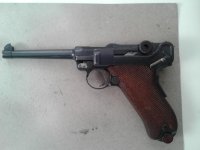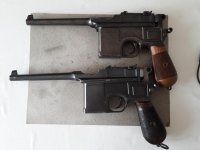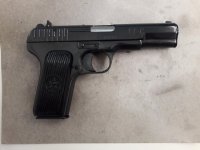Echo40
Member
- Joined
- Sep 25, 2017
- Messages
- 4,030
- Reaction score
- 7,821
So, I recently ordered a Romanian MilSurp Tokarev TT33 chambered in 7.62x25 Tokarev and have since been doing some research on the cartridge to keep me busy in the meantime. Based on what I've read, it seems to be an excellent little cartridge which launches an 88gr .31cal projectile at anywhere from 1400-1800fps, delivering anywhere from 390-500ft-lbs of energy, yet the cartridge was never really popular outside of ComBlok countries, and the military in that part of the world dropped it in the 1950s in favor of the 9x18 Makarov cartridge.
This got me to thinking, why is it that bottlenecked pistol cartridges never seem to catch on? They all tend to boast higher velocities, deeper penetration, and faster expansion than other cartridges in their "weight class" for lack of a better term, yet they always end up niche at best in terms of mainstream appeal.
Many of them have come and gone (figuratively speaking) since the early days of semiautomatic pistols, and although some of them were semi-successful for a time like the 7.63x25 Mauser, most of which never really gained mass market appeal. 7.62x25 Tokarev, 9x25 Dillon, 5.7x28 FN, .32 NAA, .25 NAA, .357 SIG, .22 TCM, just to name a few. Granted that not all of them had a clearly defined niche, but 5.7x28 FN and .357 SIG did, were backed by big name companies, and even saw some use in various Law Enforcement Agencies. However, they never broke into the mainstream market, in spite of offering something of tangible value like the equivalent performance of a 125gr .357 Magnum out of a 4" Revolver barrel in a semiautomatic pistol.
What is it that prevents bottlenecked pistol cartridges from achieving mainstream popularity? They clearly have their advantages, yet they always seem to get passed on in favor of more established cartridges. Why?
This got me to thinking, why is it that bottlenecked pistol cartridges never seem to catch on? They all tend to boast higher velocities, deeper penetration, and faster expansion than other cartridges in their "weight class" for lack of a better term, yet they always end up niche at best in terms of mainstream appeal.
Many of them have come and gone (figuratively speaking) since the early days of semiautomatic pistols, and although some of them were semi-successful for a time like the 7.63x25 Mauser, most of which never really gained mass market appeal. 7.62x25 Tokarev, 9x25 Dillon, 5.7x28 FN, .32 NAA, .25 NAA, .357 SIG, .22 TCM, just to name a few. Granted that not all of them had a clearly defined niche, but 5.7x28 FN and .357 SIG did, were backed by big name companies, and even saw some use in various Law Enforcement Agencies. However, they never broke into the mainstream market, in spite of offering something of tangible value like the equivalent performance of a 125gr .357 Magnum out of a 4" Revolver barrel in a semiautomatic pistol.
What is it that prevents bottlenecked pistol cartridges from achieving mainstream popularity? They clearly have their advantages, yet they always seem to get passed on in favor of more established cartridges. Why?



